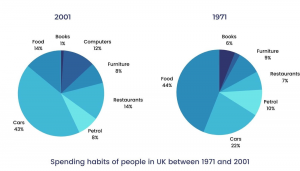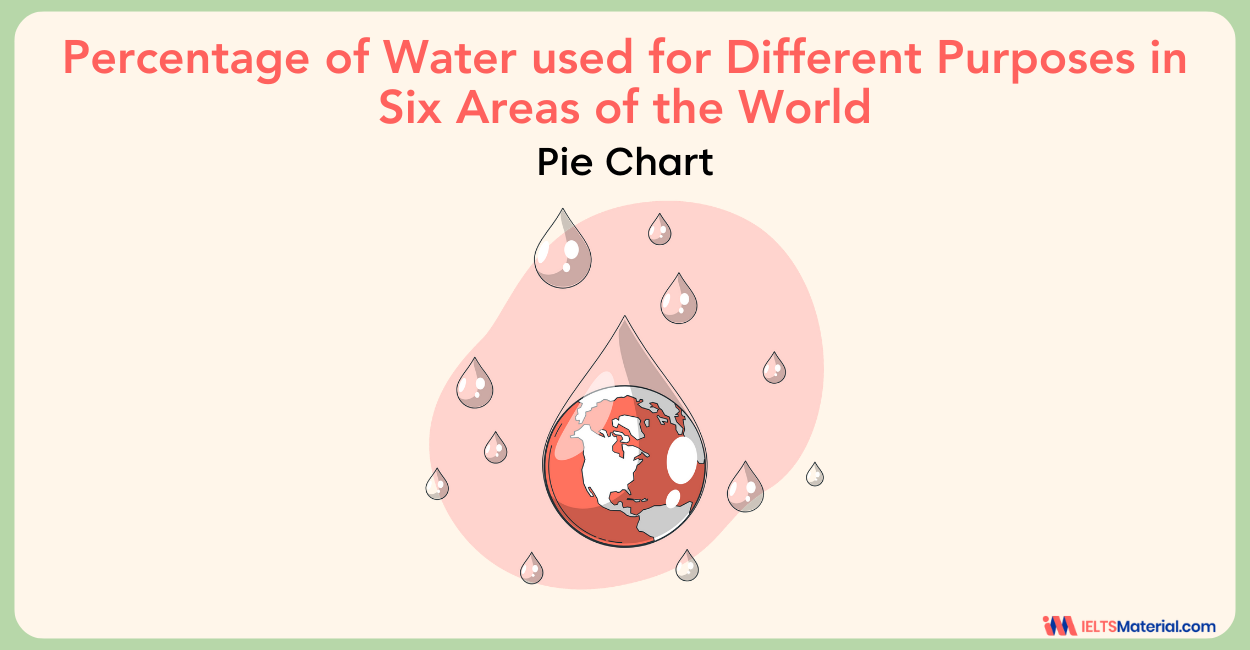Pie Chart Vocabulary for IELTS Preparation – with Pie Chart Sample Answers, Topics and Tips.
IELTS Pie charts display data in percentages. Key steps to describe them are writing an introduction, overview, and detailed description, using specific vocabulary for fractions and trends. Also, maintain tense consistency and word count.
Table of Contents
Limited-Time Offer : Access a FREE 10-Day IELTS Study Plan!
Pie Chart question types are often seen on the IELTS test. In IELTS Writing Task 1 of the Academic section, there will be a visual representation or a diagram on which you have to write a paragraph. One of these visual representations may be pie charts.
Given below are some IELTS Pie Chart example questions with explanations and helpful tips. Take a look at the Pie Chart vocabulary and ways to frame the answer for a high score.
What is an IELTS Task 1 Pie Chart?
- IELTS pie charts are circular charts that are divided into sections or pie slices, usually representing the percentages.
- Each section of the pie chart shows the percentage of data that it represents. When you put all the sections together, it forms a circle.
- The pie charts are most commonly used in the multimedia and the business world and are less commonly used in scientific and technical publications.
IELTS Pie Chart Vocabulary
In Writing Task 1 of IELTS Academic, there is a dedicated vocabulary for the pie chart. IELTS pie chart description must be done accordingly.
Here is some sample vocabulary to describe your pie chart effectively!
When describing fractions, use the words given below:
- 73% – nearly three quarters
- 51% – just over a half
- 49% – just under a half
Some other words and their synonyms are given below which you can use while writing the report on the pie chart task:
|
Word |
Related Words to Use for Pie Chart |
|
Rise |
Climb, go up, increase, improve, jump, leap, move upward movement, skyrocket, soar, shoot up. |
|
Fall |
Collapse, decline, decrease, deteriorate, dip, dive, fall (back), go down, go into free-ball, plummet. |
|
Flat |
No change, constant, remained stable, steady. |
|
Equivalent |
Commensurate, comparable, equal, similar, same, like, matching, identical. |
|
Constant |
Steady, uniform, unchanging, invariable, continuous, persistent. |
Interpreting IELTS Pie Charts
In IELTS Writing Task 1 of the Academic type, one of the question types is Pie charts that can be used to show visual data. IELTS Pie charts are circular graphs separated into sectors or ‘pie slices,’ which typically depict percentages. The size of each pie slice signifies the relative amount of data it represents. The slices form a complete circle when joined together. Let’s see an example of how to answer a basic pie chart.
From the above given IELTS Task 1 pie chart, we can answer the following questions:

What is the largest proportion of jobs?
Manufacturing
What is the smallest proportion of jobs?
Janitorial
How to Write a Task 1 Pie Chart?
When it comes to writing a pie chart description, you need to be wary of the following steps to score the highest possible band:
1. Penning Down the Introduction
Before you start describing a pie chart, you would have to learn how to write an introduction in IELTS Writing to commence with an appropriate introduction. It should be wrapped up in two sentences. And, when you write an introduction, you must paraphrase the information given in the question. You would have to include two-pointers. The first would be what precisely the chart is showing, and the second is the time period.
2. Writing the Overview
The second paragraph will be about covering the general, basic overview of the pie chart. You would have to choose a few primary features from the given chart and explain the same. First, you can take the smallest or biggest sections from the pie chart and jot down the explanation. Second, you can figure out the ones that did not change over the period of time. Ensure that you outline the significant changes in the chart.
3. Mentioning Certain Details
In the last paragraph, you will have to write specific details. You can split them up into two or three paragraphs if you want. While doing so, you can choose to create one paragraph on the basis of sectors that saw an increment, and the second paragraph could be about factors that either didn’t change or have decreased/increased.
To crack IELTS task 1 writing, get in touch with our expert trainers for a FREE session!
10 IELTS Task 1 Pie Chart with Sample Answers
Now that you have an idea about pie charts, let us look at some examples with sample answers.
Example 1

The chart shows the main methods of transportation for people travelling to a university for work or study in 2004 and 2009. Summarize the information by selecting and reporting the main features and make comparisons wherever relevant.
Example 2

The pie chart below shows the proportion of different categories of families living in poverty in UK in 2002.
Summarise the information by selecting and reporting the main features, and make comparisons where relevant.
Example 3

The pie charts show the average consumption of food in the world in 2008 compared to two countries; China and India.
Write a report to a university lecturer describing the data.
Example 4

The pie charts below show the percentage of housing owned and rented in the UK in 1991 and 2007. Summarize the information by describing the main features of the charts and making comparisons where appropriate.
Write at least 150 words.
Example 5

The pie charts show the average consumption of food in the world in 2008 compared to two countries; China and India. Write a report to a university lecturer describing the data. Write at least 150 words.
Example 6

The graphs show changes in the spending habits of people in the UK between 1971 and 2001. Write a report to a university lecturer describing the data. Write at least 150 words.
Example 7

The pie chart below shows the proportion of different categories of families living in poverty in the UK in 2002. Summarise the information by selecting and reporting the main features, and make comparisons where relevant. Write at least 150 words.
Example 8

The graphs indicate the source of complaints about Bank of America and the amount of time it takes to have the complaints resolved. Summarise the information by selecting and reporting the main features, and make comparisons where relevant. Write at least 150 words.
Example 9

The pie graphs show the nutritional consistency of the two dinners. Write a report to a university lecturer describing the data. Write at least 150 words.
Example 10

The pie charts below give information on the ages of the populations of Oman and Spain in 2005 and projections for 2055. Summarise the information by selecting and reporting the main features and make comparisons where relevant. Write at least 150 words.
Points to Remember while Writing a Pie Chart
There are a few points that should be borne in mind while explaining the pie chart. They are as follows:
- What you write must match the tense. This means that if the picture of the pie chart is in the present, then your explanation should also be in the present tense. If your chart represents the past, then your explanation should be in the past tense.
- The answer that you write should be 150 words. It might get rejected, otherwise. When you write the explanation, you must ensure that your answer is at least 155- 160 words, so that it doesn’t get rejected.
- Many times, comparing two charts is easier than writing an explanation for a single chart. So you need to focus on every detail in order to get strong points to write regarding the chart.
- The answer that you write must match correctly with the chart. You need to be extremely careful while writing the explanation. So take a clear look at the chart before beginning to write on it.
Also Check: How to Do IELTS Writing Task 1 With Only One Chart?
Tips for Describing Pie Charts
- You have to read the heading and the data labels of the chart carefully so that you get to know what the main details include and get an idea of how to write the explanation for the same.
- While writing the introduction, you need to refer to the chart which you are going to explain.
- In the subsequent paragraphs, you can show a comparison between the two pie charts. It may be either differences or similarities.
- When describing a pie chart, you must make use of appropriate IELTS Grammar and vocabulary. For example, when relating information, use words like ‘related to’, ‘connected to’ and so on.
- Usually, the largest section in the pie chart will be important. You can skip the sections that will have “other” if you do not have much time, and if the word count is already more than 150 words.
- You can use different words while describing proportions and percentages.
- Do not mention anything which is not included in the pie chart data. There must be no deviations from the data that is given.
- You must read the question carefully so that you know in what tense it is set.
- Your answer should also be in the same tense. Usually, the chart given will be in the past tense. So your explanation should obviously be in the past tense.
For Example:
In writing task 1 of the Academic module, there is a dedicated vocabulary for the pie chart. IELTS pie chart description must be done accordingly. Here are some samples of IELTS Vocabulary:
When describing fractions, use the words given below:
- 73%- nearly three quarters
- 51%- just over a half
- 49%- just under a half
When describing increases/decreases, use the words given below:
Noun phrase + verb + adverb
Eg: The price of tomatoes fell sharply.
There + be + noun + in + noun phrase
Eg: There has been a sharp decrease in the price of leather goods.
Some More IELTS Pie Chart Topics
Here is the list of IELTS Writing Task 1 pie chart topics, which you can refer to while preparing for IELTS,
Frequently Asked Questions
What is a pie-chart?
Is there a dedicated vocabulary for the pie-chart?
What is the structure for describing a pie-chart?
What significance does time period have in a pie-chart? Will it be mentioned in the pie chart?
If I observe any trend from the pie chart and if I know the reason for it, can I add the reason? Will it improve my score?
Practice IELTS Writing Task 1 based on report types
Start Preparing for IELTS: Get Your 10-Day Study Plan Today!
Explore other sample Pie Charts

Janice Thompson

Janice Thompson

Janice Thompson
Recent Articles
Kasturika Samanta
Janice Thompson

Janice Thompson





Post your Comments